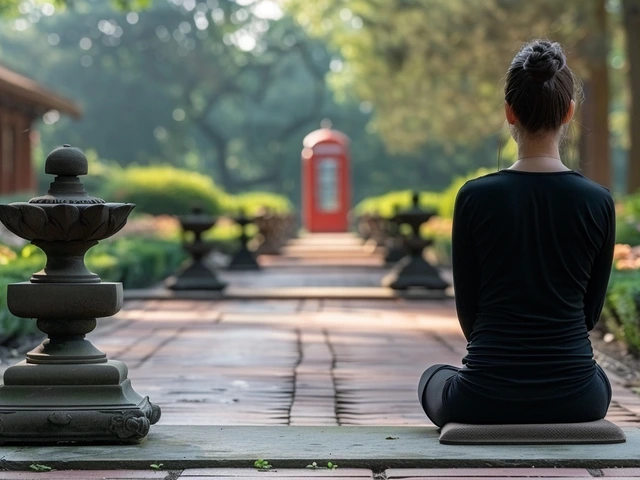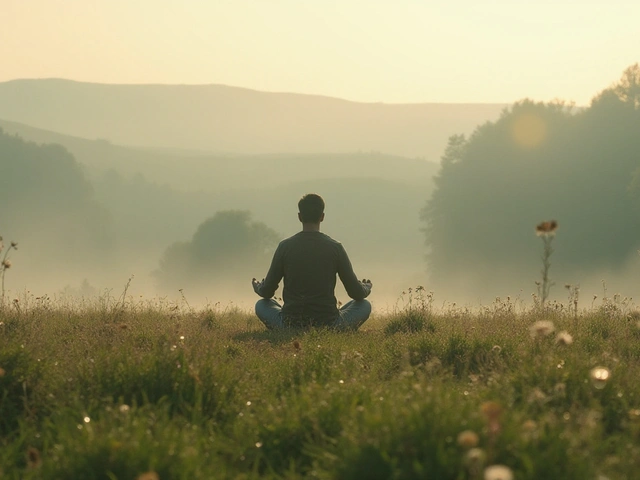Anxiety can be like an unwelcomed guest that often overstays its welcome. But what if you could use calmness as your secret weapon to gently show this intruder the door? The power of maintaining serenity cannot be underestimated when it comes to combating anxiety.
Calmness is not just about feeling relaxed in the moment; it's a proactive strategy for long-term emotional health. In this article, you will learn how a calm outlook helps manage stress hormones and promotes a sound mind. Techniques such as deep breathing, mindfulness, and meditation play pivotal roles.
While these mental strategies are vital, creating a physical environment that supports tranquility is equally crucial. From the arrangement of your living space to the type of music you listen to, small changes can make a big difference in fostering a calming atmosphere. By understanding and applying these principles, you lay a foundation for a healthier and more peaceful everyday experience.
- The Science of Calm
- Breathwork and Meditation
- Creating a Calm Environment
- Daily Practices for Sustained Calmness
The Science of Calm
Understanding the biological and psychological foundations of calmness is essential in harnessing its benefits against anxiety. When you experience calm, your brain is influenced by a drop in cortisol, the stress hormone, and an increase in serotonin and dopamine, neurotransmitters associated with happiness and relaxation. This biochemical shift not only makes you feel better in the moment but also significantly improves your overall well-being by reducing the risk of stress-related disorders.
Research in neurology points towards the amygdala and the prefrontal cortex as critical areas in the brain involved in managing stress and emotions. The amygdala senses threats and can trigger a fight-or-flight response, while the prefrontal cortex is responsible for regulating emotions. Practices aiming for calmness, such as meditation and controlled breathing, strengthen the prefrontal cortex's ability to modulate amygdala's reactions to perceived threats and stress.
Mindfulness meditation, a technique focused on being intensely aware of what you're sensing and feeling in the moment, without interpretation or judgment, has been shown to reduce the reactivity of the amygdala and boost the resilience of the brain against anxiety. This supports the idea that cultivating a mental state of calm can place you in a better position to handle life's stresses, from minor irritations to significant upheavals.
Breathwork and Meditation
Breathing is not just an involuntary action that sustains life; it is also a powerful tool that can be consciously manipulated to achieve a profound sense of calm. When anxiety levels rise, breathing often becomes quick and shallow, a natural response to stress that can further aggravate feelings of tension and panic. However, by changing the way we breathe, we can directly influence our body's autonomic nervous system, shifting from a state of hyperarousal to one of relaxation. Techniques such as deep breathing, diaphragmatic breathing, and controlled breathwork have been shown to decrease stress hormones in the body, promote better oxygen flow, and elevate one's overall mood.
Meditation complements breathwork as it guides the mind to focus and settle. It isn't merely a practice of quietude but a structured approach to training the mind to achieve clarity and emotional stability. Over time, regular meditation can rewire brain pathways, enhancing areas related to emotional regulation and reducing those associated with anxiety and stress. Newcomers to meditation often benefit from guided sessions that help them understand how to control their thought processes and maintain a focus on present-moment experiences, away from the usual chaos that may pervade their minds.
Integrating breathwork and meditation into daily routines doesn't require substantial time investments. Starting with just a few minutes a day can lead to noticeable benefits. For instance, the '4-7-8' breathing technique, a method taught by Dr. Andrew Weil, involves inhaling for 4 seconds, holding the breath for 7 seconds, and exhaling for 8 seconds. This simple practice can act as a rapid calming agent, reducing anxiety almost instantaneously. As mastery over these methods grows, so does one's ability to remain calm under stress, enhancing overall well-being and life satisfaction.
Scientific studies have provided empirical support for these practices. Research indicates that participants who engage in consistent meditation and breathwork report significantly lower levels of stress and anxiety compared to those who do not practice these techniques. This evidence not only highlights the effectiveness of such practices but also encourages their regular integration into daily life for mental health maintenance and improvement.
Creating a Calm Environment
Imagine entering a room that instantly makes you feel at peace; where the chaos of the outside world seems to melt away. This isn't just the stuff of dreams, it's entirely achievable by consciously designing a serene space. A significant part of managing anxiety involves curating your physical environment to promote calmness. It's about creating a sanctuary that not only soothes your senses but also restores your mind.
The colors you choose for your walls, the arrangement of furniture, and even the lighting are not merely aesthetic choices—they are psychologically impactful. Soft, earthy tones like pale blues, greens, and greys are known for their calming effects. There's scientific backing to this as well; studies have shown that these colors can significantly lower blood pressure and heart rate, inducing a state of calm. To augment this effect, consider incorporating elements of nature such as indoor plants or water features, which bring a slice of the tranquil outdoors into your home.
Noise control is another crucial factor. In our bustling world, the incessant noise can be a significant source of stress. Simple solutions like soundproofing your windows or using white noise machines can profoundly enhance the tranquility of your environment. Additionally, the texture of materials you surround yourself with can influence your mood. Soft furnishings like plush rugs or velvet throw pillows add a tactile sense of comfort that can help ease anxiety.
Lastly, consider the layout of your space. Clutter is often directly linked to increased anxiety and stress levels. A minimalist approach isn't just a trend—it's a way of removing unnecessary stimuli from your environment. Organizing and decluttering can transform a chaotic space into a haven of peace. Emphasize the importance of this by regularly dedicating time to maintain order, ensuring your space always remains a bastion of calm.
Your living environment should be a refuge, not a source of stress. By taking control of your surroundings and tailoring them to foster calmness, you actively contribute to your mental and emotional health. Each small change you make is a step towards a more serene life, proving that sometimes, the best defense against anxiety is a well-crafted sanctuary.
Daily Practices for Sustained Calmness
Maintaining calmness isn't just a skill; it's a daily commitment. To integrate tranquility into your life, it is crucial to develop routines that reinforce a state of peace each day. These practices are anchored in simplicity and can be seamlessly woven into even the busiest schedules. For instance, starting the day with ten minutes of mindful breathing can set a grounded tone for the hours to come. It is well-known that stress reduction is linked to consistent practice rather than sporadic efforts. The idea is to make calmness a habit, something as integral to your daily routine as brushing your teeth.
One effective method to cultivate calm is to dedicate time each evening to reflect on the day's events. This practice, often referred to as 'journaling', allows you to process daily experiences and shed the emotional burden they may carry. It helps in recognizing triggers and patterns in your life that contribute to anxiety. By understanding these patterns, you can develop strategies to manage them more effectively. Whether these reflections are captured in a notebook or a digital app, the act itself helps in decompressing and setting a restful tone for the night.
Physical activity is also a cornerstone of maintaining calmness. Engaging in regular exercise, particularly in activities like yoga or tai chi, not only strengthens the body but also clears the mind. These activities are praised for their rhythmic, meditative movements that enhance mindfulness and physiological stability. Regular physical activity helps in balancing the body's stress hormones, such as cortisol, and increases the production of endorphins, the body’s natural mood elevators.
Incorporating calming practices into daily routines allows for a sustainable approach to managing stress and anxiety. These routines should not be rigid but adaptable, based on one's personal schedule and needs. The key is consistency, and the recognition that sustained calmness is a major player in improving overall well-being and mental health. While each person’s journey to calmness may look different, the universal truth is that deliberate, daily practice paves the road to a more peaceful mind.





